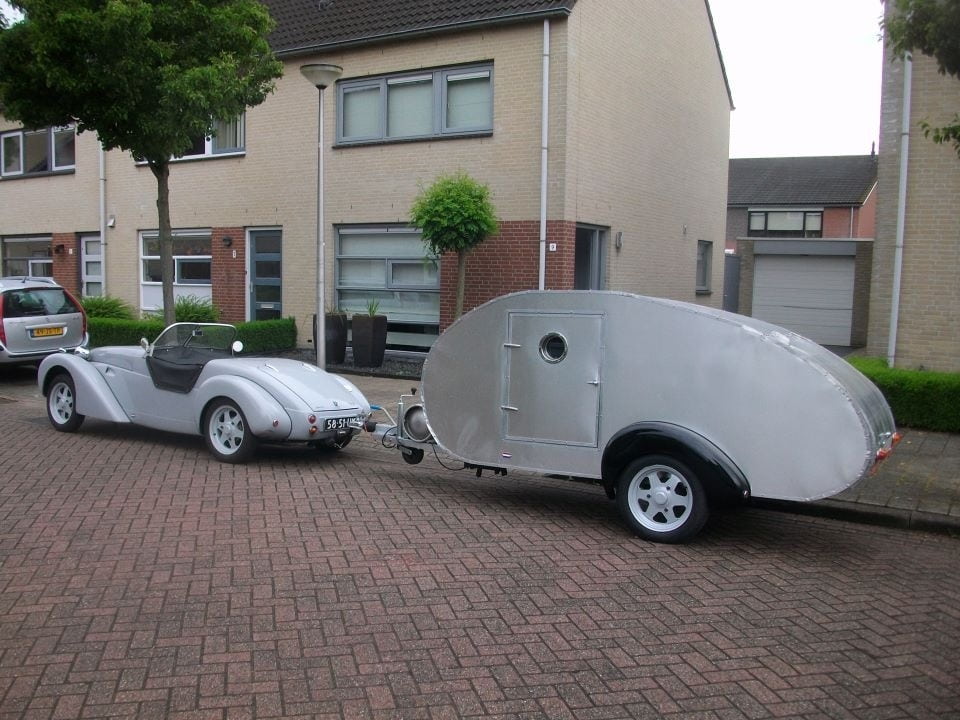 by Corwin C » Fri May 13, 2011 10:16 am
by Corwin C » Fri May 13, 2011 10:16 am
This is such a controversial subject and I think that part of the issue is terminology. For example, the term "ground" is used several ways when speaking of things electric.
When working with DC there are two wires, a positive(+) and a negative(-) which is commonly referred to as ground. Many choose to use metallic components of the trailer to provide a path for the negative flow instead of the second wire. I choose to run the wire so I'm not relying upon non-electrical components to provide an electrical path. If a problem occurs the power available is generally too low to cause physical harm to humans or animals. DC is generally self-contained and there is no reason for the energy to leave the trailer (it's usually trying to get back to the battery which normally is on the trailer.) It can cause fires or other damage, however, so absolutely always make sure you have a fuse or circuit breaker somewhere in the loop (preferably close to the positive source.)
When working with AC there are three wires, a hot (actually alternates +/-), a neutral (return path for the current), and a ground (usually bare wire in household applications). The ground is there ONLY for safety. In normal use, there is no current in the ground wire. If there is a problem, however, the wiring should be designed so that the ground will provide a solid, reliable return path instead of a human or animal. With AC I do electrically bond the trailer to the ground so that if a metallic component becomes hot there is a return path for that energy to go (and hopefully trip a GFCI so I know there's a problem.) Our trailers are essentially electrically isolated from the Earth by tires & etc. It would be potentially tragic to have someone touch the trailer somewhere and end up becoming that return path. Since neutral and ground are both return paths for electrical energy, at some point they are bonded together in a main electrical box or somewhere similar. Do not do this in the trailer if your GFCI is in the cord which supplies power to your trailer. You could be defeating the GFCI by bonding them together. I check for correct wiring at the source and the neutral and ground are completely separate within the trailer. Also, since the AC ground shouldn't be carrying current, it should not affect DC even if your DC wiring relies on the chassis for the return path.
A couple more things ... colors mean nothing. Different countries, manufacturers, builders, etc. will use any color for any wire. Don't fall into the trap that the green is always ground or that the red is always hot. The only way of knowing is to check. I have run into wiring where ALL the wires were black. Buy a simple inexpensive multimeter and learn how to use it. A multimeter is a most useful tool for checking and troubleshooting if you know how to use it.
Now to your questions ...
1. (Assuming AC) Grounding to the wood frame will accomplish nothing. Wood is generally an insulator and will not carry much current. If you are using a metal box, ground the box. Always ground to metal, the main path being your AC ground wire. Ground the aluminum siding, trailer frame, etc. and electrically bond them together as well if there is the possibility of them becoming energized.
2. Ground the chassis as near as possible to the AC source. The breaker box is usually a good place. You are trying to provide the shortest, easiest return path possible to avoid a shock. Multiple connections are a good thing if a metallic component could become energized and is isolated from the chassis. (i.e. separate electrical bonding for anything metallic - trailer skin, copper plumbing, metal sinks, door and window frames, etc.) In many cases all of this is overkill, try to visualize how something could become energized (shutting a door on a power cord?! driving a screw into your wiring?! chafing of insulation on a sharp edge?!) Remember, the ground should never have current other than when something fails.
3. Asking questions and becoming educated is the best thing that you can do. This is a controversial subject on this forum, so take any (and all) advice with a grain of salt. There are some suggestions out there that are absolutely incorrect and even dangerous. Not intentional ... but there is bad information out there. Electrical wiring is not difficult, but it does require some thought and understanding. Do not cut corners or make due. Use proper materials and techniques. Have a GFCI at or near the source of your AC power, and check for correct wiring at the source before you plug in (there are inexpensive testers to do this easily and inexpensively.)
Corwin

 If I am unwilling to stand up straight before the world and admit what I have accomplished during the day, without excuses, in complete and honest detail, then I can do better ...
If I am unwilling to stand up straight before the world and admit what I have accomplished during the day, without excuses, in complete and honest detail, then I can do better ...
and no one should be expected to accept anything less. -- myself

